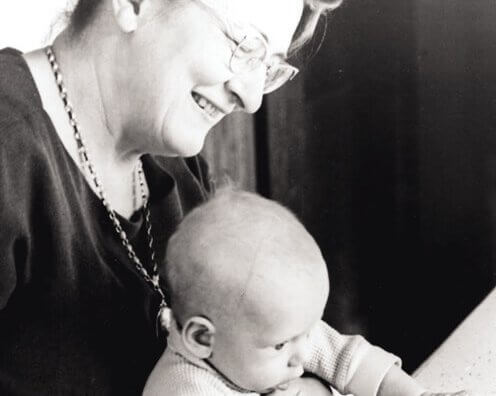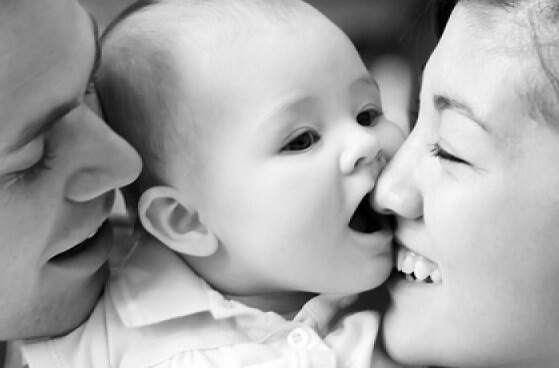Do You Know What Attachment Avoidance Is?

When the adults who care for us carry out their role well we’ll most likely develop a secure kind of attachments, independent of our temperament. We depend on the other person, but that doesn’t give rise to any feelings of anxiety or frustration. On the other hand, when we’re unattended, or rejected, it’s most likely we’ll develop bonds of insecure attachment. This is a form of dependence loaded with distress and indifference.
“Enemies like hatred and attachment have no legs, arms, or any other limbs, and they don’t have any courage or skill. So then, how have they turned me into their slave?”
-Shantideva-
The way these bonds form in our first years of life will have a lot of influence over the way we form affective relationships with other people. Unless we make a conscious intervention in that area. So, we could say that those bonds leave a deep, almost permanent mark. In that way, what we’re able to observe in adult age is a tendency to replicate the style of attachment that reinforced a person in their infancy. In some way or another early relationships of attachment have already told us what we can or can’t expect from other people, whether it’s true or not.
The Theory of Attachment
John Bowlby, a British psychoanalyst, got interested in the concept of attachment and developed a theory about it. Based on his observations he established the idea that we have a phylogenetic predisposition to developing bonds. These bonds are especially directed towards all the people who give us protection and security. Or the people who, whether they do or not, are supposed to give them to us.

More recently, the psychologist Mary Dinsmore Ainsworth identified three kinds of attachment. These are: secure attachment, indifferent or resistant attachment, and avoidance or rejection of attachment. According to her research, the majority of people develop the first kind. But there are also a lot of people who fall under the other two categories.
Secure attachment allows us to construct tight and spontaneous affective bonds. Insecure attachment (ambivalence and avoidance) make space for heavy repression and difficult creating intimate ties with other people.
Where the Kinds of Attachment Come From
When parents have a good attitude and the adequate availability for their child, they form tight bonds of security. In this scenario the children act in a predictable way. If their mother moves away, they cry and feel uncomfortable for a few seconds until they get their bearings. When she comes back, they demonstrate happiness and express affection and joy.

If the parents are outwardly distant or even just display any sign of rejection towards their child, or if on the other hand they’re too overbearing, it’s most likely that the baby/child will develop an insecure kind of attachment. When this happens, the children see their needs won’t be satisfied or are afraid they won’t be satisfied for a while. Hence their anxiety or the avoidance as a way of protecting themselves against the abandonment or indifference they’re anticipating.
They might even learn that displays of affection annoy the people who most love them: their parents. So, the little ones start to spare them from their emotions. In these scenarios, when the mother moves away, the child barely reacts. And when she comes back, the child stays distant and self-absorbed. That’s how they develop false independence.
The Effects of Attachment Avoidance, and How to Overcome It
The effects of attachment avoidance follow you all the way to adulthood. Children who’ve been raised in those conditions turn into adults who turn out to be nearly incapable of expressing their emotions. But not just expressing them, but also feeling and identifying them. They’ll try to distance themselves emotionally from everything and everyone. They might be indifferent around others and ambivalent about their own emotions.
“They’re people who’ll try to find a solution to their problems in the outside world, since they don’t put any conscious value on the internal one”
This situation is especially reflected in the world of couples. They get anxious about losing their loved one. They think by not showing or minimizing their emotions they’ll protect against some eventual suffering. They run away from authentic dialogues and get scared before they even happen. Instead of expressing their disapproval with words, they’ll do it with tantrums and fake conflicts. They suffer a lot because they can’t love calmly. Instead they love as if there were a serious threat hanging over their heads. A threat that a lot of the time they’re unable to identify.
Although patterns of attachment tend to remain, it’s always possible to refine and polish them. Sometimes an experience of losing one of those loved ones brings with it a reflection and change of patterns. Sometimes people achieve it by seeing a psychotherapist. It’s also possible to become conscious of it and work on it individually in order to learn how to connect to the world in a more constructive way.
Overcoming attachment avoidance works by restoring the relationship between the person and their internal world. In a lot of cases it works by regaining a damaged, unidentifiable, and painful lack of self-esteem. Only when this relationship is healthy is it possible for the person to think about the internal worlds of the people around them. So, the possibility of empathy in thinking about everyone else’s emotions can only be born once they start thinking about their own.
So, in this sense, it’s very important to change our patterns of communication. To open them up, for better or worse. That way we can have the ability to expression our emotions in a controlled way that will give everyone else a chance to accept them, validate them, and in some case, go along with them.
It sounds easy when we say it like that, but if it’s hard to learn, it’s even harder to unlearn. It’s thought that what we learn as infants, or a lot of what we learn, is the base where we’ve constructed the rest of the knowledge and habits that characterize us now. Sometimes it’s highly advisable to get help from a professional. But the earthquake we might cause by moving a piece as important as our style of attachment might destroy us.
When the adults who care for us carry out their role well we’ll most likely develop a secure kind of attachments, independent of our temperament. We depend on the other person, but that doesn’t give rise to any feelings of anxiety or frustration. On the other hand, when we’re unattended, or rejected, it’s most likely we’ll develop bonds of insecure attachment. This is a form of dependence loaded with distress and indifference.
“Enemies like hatred and attachment have no legs, arms, or any other limbs, and they don’t have any courage or skill. So then, how have they turned me into their slave?”
-Shantideva-
The way these bonds form in our first years of life will have a lot of influence over the way we form affective relationships with other people. Unless we make a conscious intervention in that area. So, we could say that those bonds leave a deep, almost permanent mark. In that way, what we’re able to observe in adult age is a tendency to replicate the style of attachment that reinforced a person in their infancy. In some way or another early relationships of attachment have already told us what we can or can’t expect from other people, whether it’s true or not.
The Theory of Attachment
John Bowlby, a British psychoanalyst, got interested in the concept of attachment and developed a theory about it. Based on his observations he established the idea that we have a phylogenetic predisposition to developing bonds. These bonds are especially directed towards all the people who give us protection and security. Or the people who, whether they do or not, are supposed to give them to us.

More recently, the psychologist Mary Dinsmore Ainsworth identified three kinds of attachment. These are: secure attachment, indifferent or resistant attachment, and avoidance or rejection of attachment. According to her research, the majority of people develop the first kind. But there are also a lot of people who fall under the other two categories.
Secure attachment allows us to construct tight and spontaneous affective bonds. Insecure attachment (ambivalence and avoidance) make space for heavy repression and difficult creating intimate ties with other people.
Where the Kinds of Attachment Come From
When parents have a good attitude and the adequate availability for their child, they form tight bonds of security. In this scenario the children act in a predictable way. If their mother moves away, they cry and feel uncomfortable for a few seconds until they get their bearings. When she comes back, they demonstrate happiness and express affection and joy.

If the parents are outwardly distant or even just display any sign of rejection towards their child, or if on the other hand they’re too overbearing, it’s most likely that the baby/child will develop an insecure kind of attachment. When this happens, the children see their needs won’t be satisfied or are afraid they won’t be satisfied for a while. Hence their anxiety or the avoidance as a way of protecting themselves against the abandonment or indifference they’re anticipating.
They might even learn that displays of affection annoy the people who most love them: their parents. So, the little ones start to spare them from their emotions. In these scenarios, when the mother moves away, the child barely reacts. And when she comes back, the child stays distant and self-absorbed. That’s how they develop false independence.
The Effects of Attachment Avoidance, and How to Overcome It
The effects of attachment avoidance follow you all the way to adulthood. Children who’ve been raised in those conditions turn into adults who turn out to be nearly incapable of expressing their emotions. But not just expressing them, but also feeling and identifying them. They’ll try to distance themselves emotionally from everything and everyone. They might be indifferent around others and ambivalent about their own emotions.
“They’re people who’ll try to find a solution to their problems in the outside world, since they don’t put any conscious value on the internal one”
This situation is especially reflected in the world of couples. They get anxious about losing their loved one. They think by not showing or minimizing their emotions they’ll protect against some eventual suffering. They run away from authentic dialogues and get scared before they even happen. Instead of expressing their disapproval with words, they’ll do it with tantrums and fake conflicts. They suffer a lot because they can’t love calmly. Instead they love as if there were a serious threat hanging over their heads. A threat that a lot of the time they’re unable to identify.
Although patterns of attachment tend to remain, it’s always possible to refine and polish them. Sometimes an experience of losing one of those loved ones brings with it a reflection and change of patterns. Sometimes people achieve it by seeing a psychotherapist. It’s also possible to become conscious of it and work on it individually in order to learn how to connect to the world in a more constructive way.
Overcoming attachment avoidance works by restoring the relationship between the person and their internal world. In a lot of cases it works by regaining a damaged, unidentifiable, and painful lack of self-esteem. Only when this relationship is healthy is it possible for the person to think about the internal worlds of the people around them. So, the possibility of empathy in thinking about everyone else’s emotions can only be born once they start thinking about their own.
So, in this sense, it’s very important to change our patterns of communication. To open them up, for better or worse. That way we can have the ability to expression our emotions in a controlled way that will give everyone else a chance to accept them, validate them, and in some case, go along with them.
It sounds easy when we say it like that, but if it’s hard to learn, it’s even harder to unlearn. It’s thought that what we learn as infants, or a lot of what we learn, is the base where we’ve constructed the rest of the knowledge and habits that characterize us now. Sometimes it’s highly advisable to get help from a professional. But the earthquake we might cause by moving a piece as important as our style of attachment might destroy us.
This text is provided for informational purposes only and does not replace consultation with a professional. If in doubt, consult your specialist.







